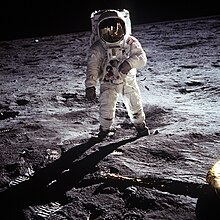The Cold War-inspired space race between the Soviet Union and the U.S. led to an acceleration of interest in the Moon. Unmanned probes, both flyby and impact/lander missions, were sent 
once allowed by launcher capabilities. The Soviet Union's Luna program was the first to reach the Moon with unmanned spacecraft. The first man-made object to escape Earth's gravity and pass near the Moon was Luna 1, the first man-made object to impact the lunar surface was Luna 2, and the first photographs of the normally occluded far side of the Moon were made by Luna 3, all in 1959. The first spacecraft to perform a successful lunar soft landing was Luna 9 and the first unmanned vehicle to orbit the Moon was Luna 10, both in 1966.[12] Rock and soil samples were brought back to Earth by three Luna missions (Luna 16, 20, and 24), which returned 0.3 kg total[117] and the Apollo missions 11 to 17 (except Apollo 13, which aborted its planned lunar landing), which returned 382 kg in 2,196 separate samples.[118]

The landing of the first humans on the Moon in 1969 is seen by many as the culmination of the space race.[119] Neil Armstrong became the first person to walk on the Moon as the commander of the American mission Apollo 11 by first setting foot on the Moon at 02:56 UTC on July 21, 1969.[120] The American Moon landing and return was enabled by considerable technological advances in the early 1960s, in domains such as ablation chemistry, software engineering and atmospheric re-entry technology, and by highly competent management of the enormous technical undertaking.[121][122]
Scientific instrument packages were installed on the lunar surface during all the Apollo missions. Long-lived instrument stations, including heat flow probes, seismometers, and magnetometers, were installed at the Apollo 12, 14, 15, 16, and 17 landing sites. Direct transmission of data to Earth concluded in late 1977 due to budgetary considerations,[123][124] but as the stations' lunar laser ranging corner-cube retroreflector arrays are passive instruments, they are still being used. Ranging to the stations is routinely performed from earth-based stations with an accuracy of a few centimetres, and data from this experiment are being used to place constraints on the size of the lunar core.[125]



0 comments:
Post a Comment